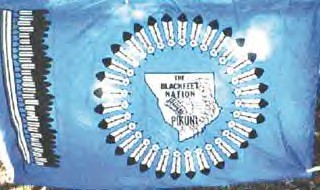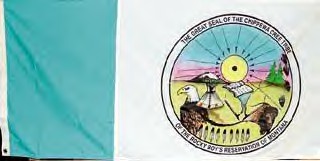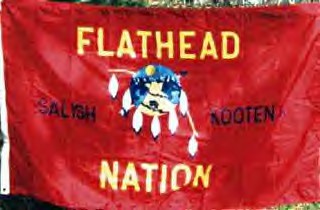|
|
Canku Ota |
|
|
(Many Paths) |
||
|
An Online Newsletter Celebrating Native America |
||
|
November 15, 2003 - Issue 100 |
||
|
|
||
|
Flags Proclaim Tribal Identities |
||
|
by Donna Healey - The
Billings Gazette Staff
|
||
|
credits: Larry
Mayer/Gazette staff Northern Cheyenne Tribal Chairwoman Geri Small is shown with the tribal flag and its distinctive Morning Star symbol. Tribal Flags:
|
|
When a New Jersey sixth-grader threw together a paper on the flags of French-speaking countries, he flunked the homework assignment, but never lost interest in the flags. "Every flag has a story. It's sort of a snapshot of what people want to say about themselves," said Donald Healy, who was that boy and who now, as an adult, works as a computer specialist designing databases for the state of New Jersey.
In the mid-1990s, at an international congress of vexillology in Warsaw, Poland, a hundred flag geeks hunkered down to hear Healy talk about Native American tribal flags. "It sort of blew away everybody in the lecture hall because nobody knew about them. Here was a whole realm of flags that had never before been seen by these people," Healy said during a phone interview from his home in New Jersey. He and Peter Orenski co-authored a book titled "Native American Flags," containing 183 tribal flags, to be released this month.
The Arapaho, on Wyoming's Wind River Reservation, designed one of the first of the modern Native American tribal flags. The idea for the flag, which was adopted in 1956, surfaced as a way to honor war veterans. The Arapaho flag contains seven stripes of red, white and black. The red symbolizes the people, the black symbolizes strength in the face of death and the white represents knowledge to be passed on to the young, according to information on a tribal Web site. A circle, within a white triangle, is divided into two parts. The circle represents the world, while the white line, which divides the circle into two semi-circles, represents the Great Spirit.
Most Native American tribes began adopting flag designs in the 1970s and '80s. The explosion in designs seems to have been triggered by a series of landmark federal statutes that strengthen tribal self-government and sovereignty rights. The proliferation of casino gaming also propelled some tribes to design flags. "We heard of dozens of instances where the reason for adopting a flag was 'we needed something to fly outside our casino,'" Healy said. Among Native American flags, Healy and Orenski have their personal favorites.
The Cheyenne flag contains the Morning Star, symbolized by a square set on a corner with lines emerging from it, set against a blue background. "Setting the square on a corner, right away it creates a dynamic," Orenski said. The striking design is distinctive and easily recognizable. "If you belong, you know the symbolism," Orenski said. Morning Star was one name for Dull Knife, the Northern Cheyenne chief who led his people on a heart-breaking journey back from their forced placement in Oklahoma to their ancestral lands in Montana.
"My theory is, they're saying this is all the land we've got left and we're telling you, 'This is ours,' " Healy said. Each element on the Crow Tribe's sky-blue flag represents sacred aspects of the traditional Crow way of life. Those images include a tepee, war bonnets, peace pipe, medicine bundle and sweat lodge. "Everything about us is on that flag," said George Reed, the tribe's secretary of cultural education. The sun and its 12 rays represent the Crow's 13 tribal clans, with the sun itself representing the Greasy Mouth clan, Reed said. The Wolf, Pryor and Big Horn mountains are also depicted on the flag. The red flag of the Flathead Nation also includes a tepee in the center. The flag is presented whenever the tribe's color guard appears at events, including parades, pow-wows and some funeral processions. The flag of the Chippewa Cree of the Rocky Boy's Reservation bears the tribal seal, with images of a tepee, eagle, buffalo head, bear paw tracks, a braid of sweetgrass, eagle feathers and peace pipes. The sun's rays on the flag represent the 15 sacred grass dance chiefs active in preserving the culture of the Chippewa Cree, while the writing under the sun represents good health and good fortune for the tribe. The Assiniboine and Gros Ventre tribes, who share the Fort Belknap Reservation, symbolize their relationship by a buffalo skull divided into two colors. Although divided, it remains one figure. A jagged line across the top of the skull represents the Milk River. Snake Butte, a well-known landmark, appears in the background.
Flags have been known to shift colors and even designs over time. Healy has seen some flags shift from light blue to purple or midnight blue depending on the color palette of the flag manufacturer. Flags can also change with the election of new tribal leaders. Healy and Orenski's book describes the buffalo skull on the Fort Belknap Reservation flag as brown and white, while a recent photograph shows the skull in black and white. The authors depict the Northern Cheyenne flag as a deep blue and white, but a flag at the tribal offices is a paler blue and yellow. While many tribal flags are filled with sacred meaning, some seem to suffer from design by committee, Healy said. Members of the Wampanoag in New England fought for 15 years over their flag's design before settling on a design this year. "If they fight over it for 15 years, it's really important to them," he said. Members of the North American Vexillological Association tend to be equally passionate.
A pet peeve among vexillologists is the use of lettering on flags. A flag is a symbol, Healy said. It should stand for what it is without the need for words. Words are hard to read on a waving flag, and, as is the case with the Montana flag, the lettering can appear backward on the flag's flip side. The most memorable designs tend to be startlingly simple, Healy said. While Healy is still collecting Native American flags from tribes in the United States, he has branched out to gather flags from Canadian tribes and indigenous Latin American peoples. In his spare time, he also delves into the relationships between flags. Healy once traced the influence of the Dutch flag - the first tricolor flag associated with a sovereign, democratic-style government - to a chain of more than 120 flags, including the state flag of New Jersey and about one-third of the national flags in Africa. He linked all of those flags back to the Dutch flag's red, white and blue horizontal stripes. On
the Net • TIME Flags of Native Americans
|
|
|
||
|
|
||
| Canku Ota is a free Newsletter celebrating Native America, its traditions and accomplishments . We do not provide subscriber or visitor names to anyone. Some articles presented in Canku Ota may contain copyright material. We have received appropriate permissions for republishing any articles. Material appearing here is distributed without profit or monetary gain to those who have expressed an interest. This is in accordance with Title 17 U.S.C. Section 107. | ||
|
Canku Ota is a copyright © 2000, 2001, 2002, 2003 of Vicki Lockard and Paul Barry. |
||
 |
 |
|
|
The "Canku Ota - A Newsletter Celebrating Native America" web site and its design is the |
||
|
Copyright © 1999, 2000, 2001, 2002, 2003 of Paul C. Barry. |
||
|
All Rights Reserved. |
||

 Healy
is a past president of a North American association of vexillologists,
"flag geeks" who spend their spare time studying flags
and their symbolism. "Vexillology" comes from the word
"vexillum," a square flag of the ancient Roman cavalry.
Healy
is a past president of a North American association of vexillologists,
"flag geeks" who spend their spare time studying flags
and their symbolism. "Vexillology" comes from the word
"vexillum," a square flag of the ancient Roman cavalry. History's
first documented use of flags by Native American tribes dates back
to the Civil War. Five tribes that had been forced to move to Oklahoma's
Indian Territory fought with the Confederacy under their own banner.
The Choctaw flag still contains element of that Civil War banner,
Healy said.
History's
first documented use of flags by Native American tribes dates back
to the Civil War. Five tribes that had been forced to move to Oklahoma's
Indian Territory fought with the Confederacy under their own banner.
The Choctaw flag still contains element of that Civil War banner,
Healy said. In
addition to proclaiming tribal identity, flags are a tool for expressing
sovereign status, Healy said.
In
addition to proclaiming tribal identity, flags are a tool for expressing
sovereign status, Healy said. "The
Northern Cheyenne flag is simple, crisp, full of meaning and one
of the best designs on the continent," Healy said.
"The
Northern Cheyenne flag is simple, crisp, full of meaning and one
of the best designs on the continent," Healy said. The
Blackfeet Nation's flag contains a map of its reservation.
The
Blackfeet Nation's flag contains a map of its reservation. A
buffalo robe stretched between two chiefs on the Fort Peck tribal
flag symbolizes the bond of friendship and understanding between
the Assiniboine and the Sioux tribes on the reservation, said Vice
Chairman Ray K. Eder.
A
buffalo robe stretched between two chiefs on the Fort Peck tribal
flag symbolizes the bond of friendship and understanding between
the Assiniboine and the Sioux tribes on the reservation, said Vice
Chairman Ray K. Eder. Healy
has collected about 500 full-size national flags and 85 tribal flags.
He recently loaned eight of the tribal flags for a film being made
for the opening of the Smithsonian Institution's National Museum
of the American Indian in the fall of 2004.
Healy
has collected about 500 full-size national flags and 85 tribal flags.
He recently loaned eight of the tribal flags for a film being made
for the opening of the Smithsonian Institution's National Museum
of the American Indian in the fall of 2004.